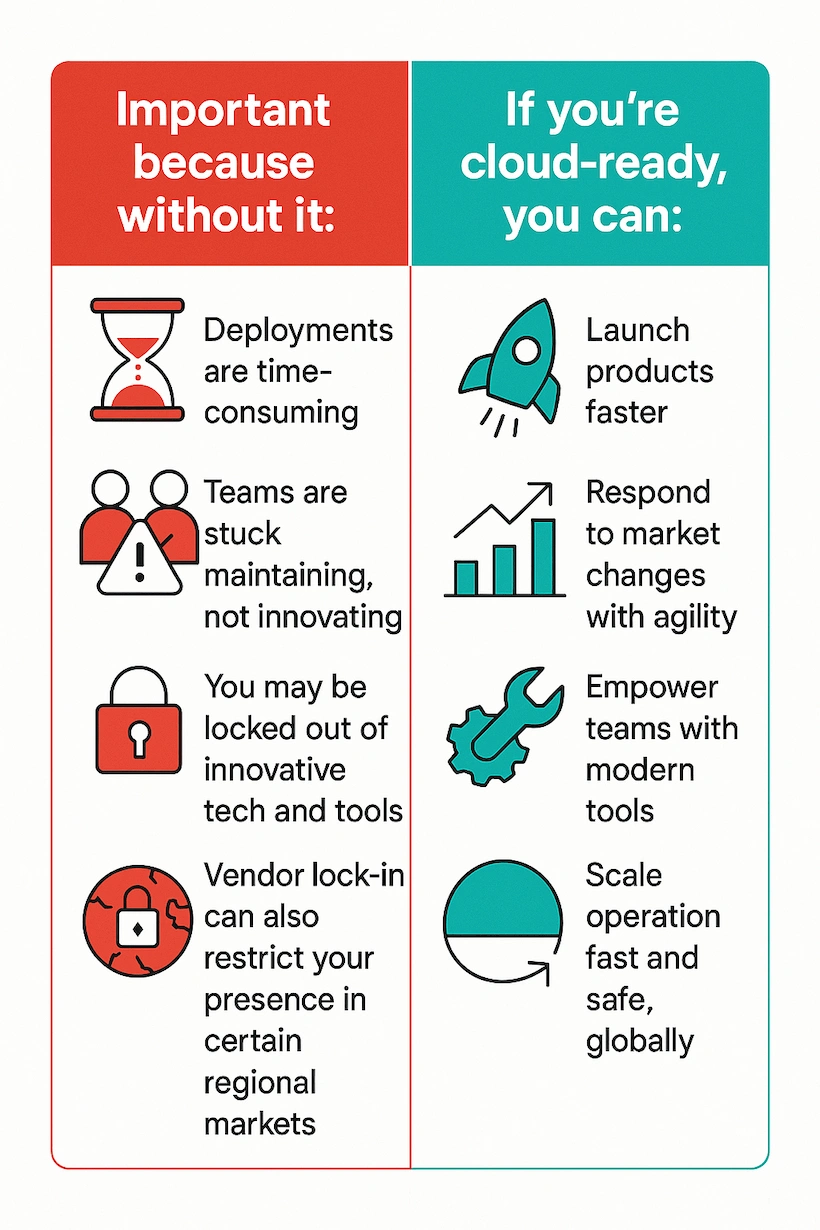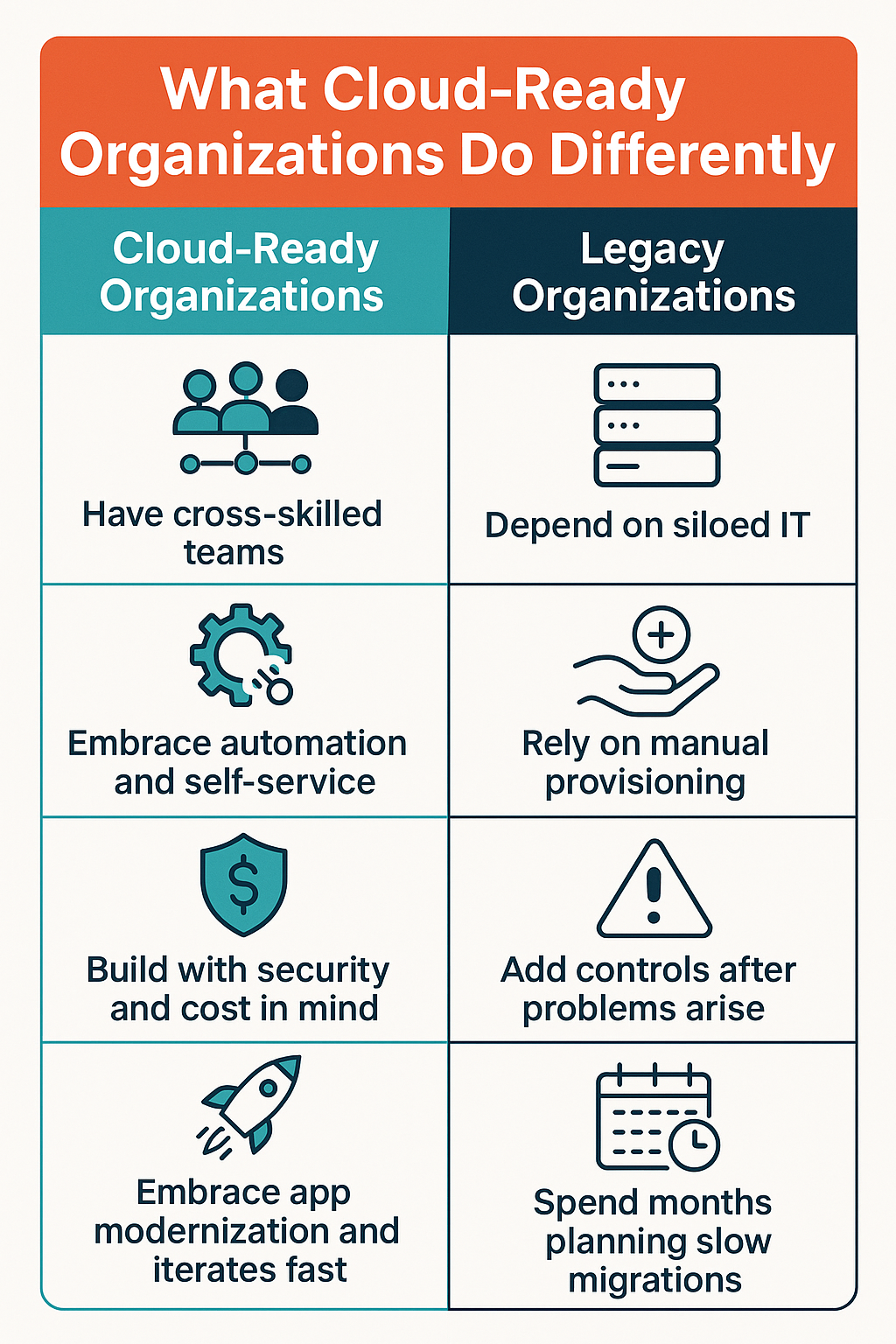Cloud readiness is your ability – both technically and culturally – to migrate to, operate in, and benefit from the cloud.
For 80% of organizations, cloud has opened up new revenue streams for innovative products. Other research has found up to 6.9% higher revenue growth among cloud adopters compared to non-adopters.
It’s safe to say, the cloud has become foundational to innovation in IoT, AI, ML, and more. That’s why roughly 87% of firms plan to increase their cloud investments. But cloud success isn’t something you can buy. It’s something you build with readiness, resilience, and a strategy that turns investment into innovation.
Cloud readiness is your ability – both technically and culturally – to migrate to, operate in, and benefit from the cloud. It also includes whether your IT infrastructure can support rapid deployment, scalability, and secure operations across cloud, multi-cloud, and hybrid environments.
Cloud readiness is important because without it:
Conversely, if you’re cloud-ready, you can:

Here’s how cloud readiness is enabling business growth, viability, and innovation across real-world enterprises and organizations.
Netflix serves billions of hours of content per month on AWS by automatically deploying thousands of servers globally in mere minutes. This cloud readiness is what enables Netflix to consistently meet global user demand without delays, downtime, or infrastructure bottlenecks.
Epic Games supports some 500M+ Fortnite players on AWS. The company relies on its cloud and infrastructure readiness to scale compute instantly to up to 30× demand during Fortnite surges. This burst capacity spanning multiple regions allows Epic Games to ensure performance never drops.
For Home Depot, being cloud ready meant it could migrate its entire on-premises data warehouse to Google Cloud BigQuery. This migration scaled its analytics platform from 450 terabytes to over 15 petabytes of data, skipping entirely the months-long capacity upgrades that it would’ve required on-prem.
Siemens AG attributes much of its operational efficiency gains to cloud and infrastructure readiness. Siemens Healthineers managed to reduce the time to register new ultrasound machines from 2 hours down to 5 minutes by using cloud-based IoT services. In its power-generation arm, Siemens Gas & Power moved critical systems to a serverless architecture, which cut control system alerts by 90% and infrastructure costs by 85%.
Genentech, a pharma company, is hoping to save about 5 years of manual effort in drug discovery via genAI Agent they’ve built on AWS infrastructure. In healthcare, roughly 70% of organizations are expanding cloud use for data access, analytics, and operational efficiency. But scaling cloud use without compromising care or compliance is only possible through solid cloud readiness.
Spotify’s cloud readiness enabled it to expand its premium subscriber base by 29%. It uses Google Cloud BigQuery and Pub/Sub to drive innovation in personalization and implement rapid iterations on cloud.
As we’ve seen, cloud-ready organizations are better positioned to scale, innovate, and respond to market demands with speed and precision. On the flip side, failing to modernize infrastructure or build cloud readiness results in:
So, building cloud and infrastructure readiness is not just a choice, it’s essential for maintaining competitive edge and business growth.
95% of organizations say lack of cloud skills is holding them back. That’s why a key foundation of cloud readiness is upskilling teams, including, cloud engineers, architects, DevOps, data analysts, and FinOps.
Recommendation: Invest in cloud certifications, cross-training, and cloud-savvy leadership.
A key part of building a growth strategy based on cloud readiness is creating cloud centers of excellence (CCoEs) to build a well-rounded cloud strategy based on solid reusable cloud foundations (automation and self-service), observability, cost visibility, and accountability.
Recommendation: Build a cross-functional cloud ops model that brings together platform engineering, development, and finance.
FinOps models and practices like real-time cost monitoring and showback/chargeback along with strategic use of RI discounts and spot instances are all common tactics to ensure high costs don’t undermine innovative projects.
Recommendation: Make cost-awareness and resource tagging a built-in part of developer workflows, and adopt tools like emma, FinOps tools, or even native cost tools to help visualize and control spend.
True cloud and infrastructure readiness involves re-architecting applications – breaking monoliths into microservices and containers – before, or instead of, lifting and shifting. Otherwise, many of the cloud benefits, like granular scalability and resource optimization, remain elusive.
Recommendation: Start small with modernization pilots. Focus on apps that can benefit most from modularity and elasticity.
For 94% of organizations, security posture is one of the top concerns for cloud readiness. To move forward with confidence, businesses must be prepared to adopt Zero Trust, implement policy-as-code, and leverage cloud-native security tools.
Recommendation: Bake security features, including identity and access control (IAM) and encryption, into the cloud blueprint.
Cloud readiness includes understanding legal and jurisdictional risks, and Sovereign Cloud initiatives by AWS, Azure, and Google reflect this shift. Cloud migration and operations must map to compliance requirements, from GDPR and HIPAA to DORA, the AI Act, and beyond.
Recommendation: Build a cloud and infrastructure strategy to support multi-region, multi-cloud, and hybrid deployments by design.

Organizations need to use a combination of platform categories, tools, and solutions to achieve and maintain cloud readiness, which requires resource and cost visibility, governance, and faster, more secure cloud operations.
Below is our breakdown of key platform/solution categories, along with our top recommended tools in each, to help you in your cloud and infrastructure readiness journey.
IaC tools help you spin up cloud environments using code in minutes, not days. They reduce manual errors and let you write the code once, then reuse it to replicate environments consistently, whenever needed.
Top Picks: Terraform, Ansible, Pulumi, AWS CloudFormation
These platforms give you the intelligence you need to optimize resource provisioning based on real-time and historical usage data. Increasingly these tools are supporting FinOps to include financial insights to lower costs and improve budgeting across business units.
Top Picks: emma, CloudHealth by VMware, FlexeraSpot
Suggested read: Top 10 Cloud Cost Management and FinOps Tools in 2025
These tools provide real-time visibility into system health, performance, and application behavior. They make sure teams detect and resolve issues faster for maximum uptime and optimal performance.
To Picks: Datadog, Prometheus + Grafana, ELK Stack
These tools centralize security ops and provide real-time visibility into risks and support security solutions and paradigms like Zero Trust architectures. They ensure business continuity and safe operations in the cloud.
Top Picks: AWS Security Hub, Azure Defender, GCP Security Command Center, Prisma Cloud (Palo Alto)
These tools automate the software delivery pipeline, which allows teams to deliver and iterate faster in cloud environments.
Top Picks: GitLab CI, Jenkins, Argo CD
Since many cloud-ready organizations cannot afford exclusivity to a single cloud platform, they need comprehensive platforms that can abstract operations like infrastructure deployment across providers for unified control. Platform consistency, global reach, and hybrid flexibility.
Top Picks: emma, VMware Tanzu, Red Hat OpenShift, Google Anthos, Azure Arc
Read our detailed comparisons to evaluate top cloud management platforms and choose the best fit for your needs:
The emma platform is an end-to-end multi-cloud management platform for deploying, monitoring, managing, and optimizing cloud costs and resources across multiple providers and on-prem environments. The platform focuses on unifying and standardizing operations across all these environments, allowing you to pick and choose, migrate, and scale readily across all the environments you own, as needed.
emma’s capabilities are purpose-built to enhance your cloud and infrastructure readiness, so you can utilize and maximize the benefits of various infrastructure environments and cloud providers to meet your growth and innovation objectives.
There’s no denying that cloud and infrastructure readiness is a business advantage. Cloud-ready organizations are 20–40% faster at launching new products, responding to market shifts with agility, and turning cloud infrastructure into a true engine for growth and innovation.
To measure your cloud and infrastructure readiness and agility, you need to assess your cloud maturity, not just in tech terms but also in business outcomes, like revenue impact, time-to-market, and innovation velocity.
You can use proven models like the AWS Cloud Adoption Framework or Gartner’s 5-Level Cloud Maturity Model to benchmark your progress, identify gaps, and define your next steps. The bottomline is: Invest in cloud readiness, measure it, and build the infrastructure capabilities that let you innovate faster and grow without tech constraints.